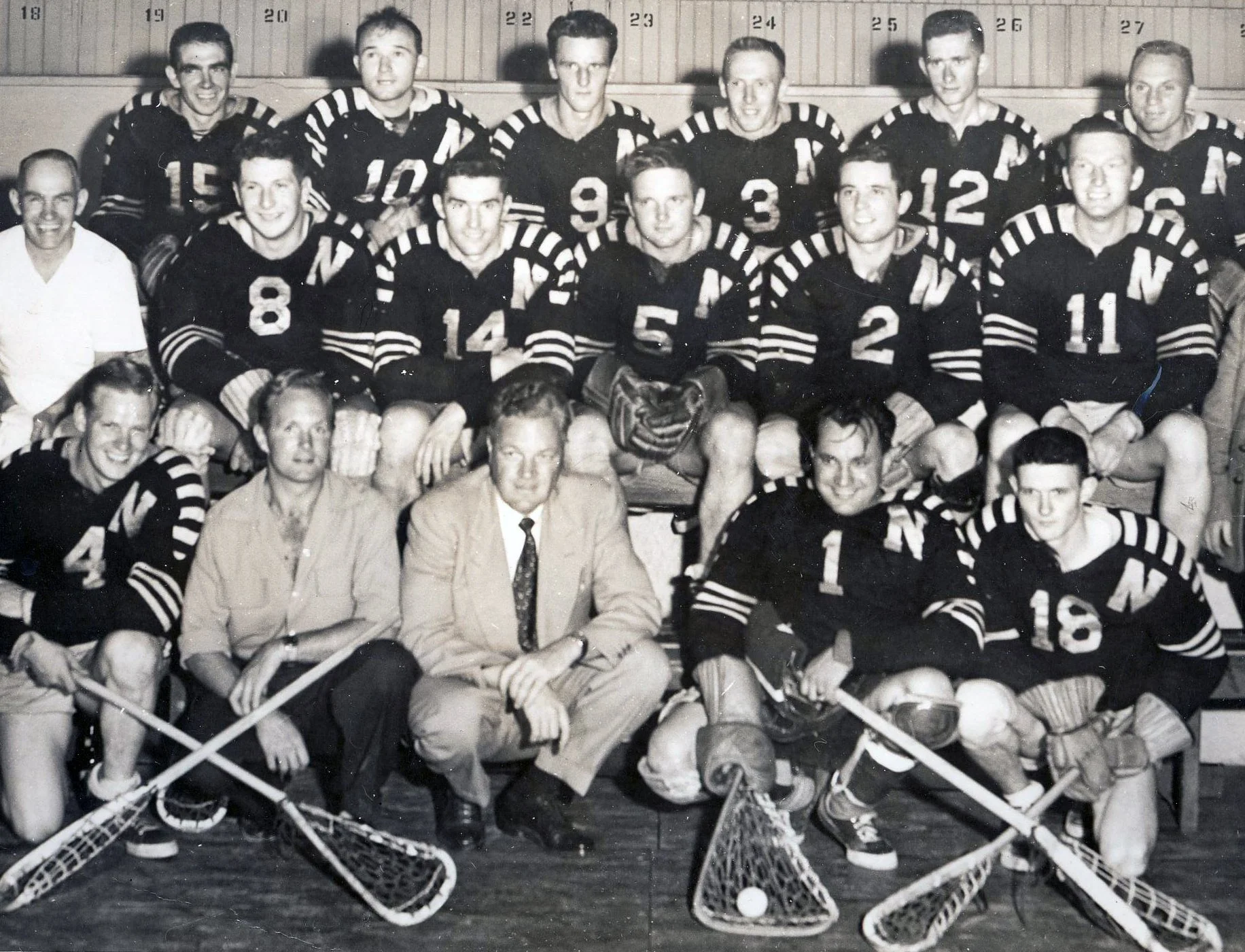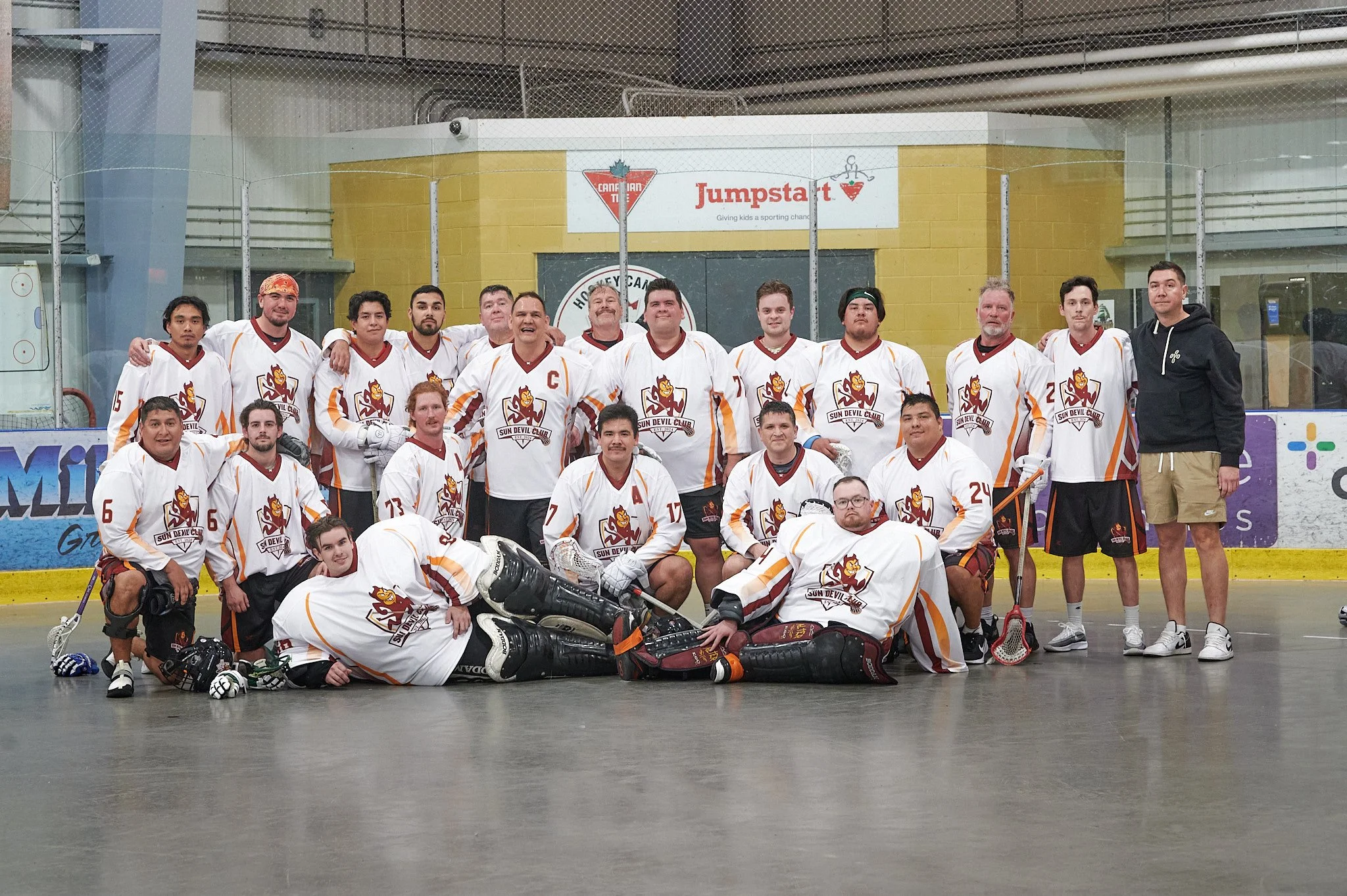The Creator’s Game: Lacrosse
Lacrosse has deep Indigenous roots in what is now Canada, with origins that trace back centuries before European contact.
The game was created and played by Indigenous Peoples across North America, particularly by the Haudenosaunee and Anishinaabe. Known by many names in Indigenous languages—such as Baggataway (Algonquin) and Tewaarathon (Mohawk)—lacrosse was far more than just a sport. It held ceremonial and spiritual meaning, helping to resolve disputes, train warriors, honour the Creator, and strengthen community ties.
Before colonization, games could last for days and involve hundreds of players, with goals set miles apart. Handmade wooden sticks and deerskin balls were used, and the game was a true test of skill, endurance, and teamwork.
European settlers first documented lacrosse in 1636, when French Jesuit missionaries observed the game and called it la crosse—meaning “the stick,” as it resembled a bishop’s staff. By the mid-1800s, settlers in Montreal began formalizing the game, blending Indigenous practices with European sporting traditions. Dr. William George Beers played a key role in codifying the first standardized rules in 1867 and promoting lacrosse as Canada’s national game. While lacrosse was declared Canada’s national sport in 1859, it is now officially recognized as the national summer sport since 1994. Today, both Indigenous and non-Indigenous communities continue to take great pride in the game.
The Rise of Box Lacrosse
In the 1930s, box lacrosse emerged as a faster, indoor version of the game, adapted for hockey arenas. Played with smaller teams, box lacrosse quickly became the dominant style in Canada. The Mann Cup—the ultimate prize in Canadian box lacrosse—is awarded each year to the Senior A men’s national champions. The first indoor Mann Cup was played in 1932 at Maple Leaf Gardens in Toronto, marking a key moment in the evolution of the sport.
Nanaimo, Snuneymuxw, and the Mann Cup
The Nanaimo Timbermen, first established as the Nanaimo Native Sons in 1951, made history in 1956. That year, they became the first western team to win the Mann Cup in Eastern Canada. With local players and talent drawn from Vancouver and beyond, the Timbermen dominated the season, winning 24 of 30 games. Key players included Bob Allen (who set a league record with 127 points), Don Sherry, Don Ashbee, and Joe White (Snuneymuxw), who played a crucial role in controlling face-offs and possession. After sweeping the Vancouver Burrards in the Western finals, they faced the Peterborough team at Maple Leaf Gardens and won the national title. The victory was celebrated with a city-wide parade and a civic reception—an accomplishment still remembered with pride.
Snuneymuxw’s Sporting Legacy
Snuneymuxw has produced many outstanding athletes, including Douglas “Doug” White. Born in 1943 to Dr. Ellen White and Chief Doug White, Doug was a gifted multi-sport athlete. He earned the prestigious Tom Longboat Trophy Medal for Western Canada, recognizing his achievements, sportsmanship, and leadership. Throughout the 1960s, Doug excelled in
lacrosse, soccer, football, and other sports, leading teams to championships and representing Nanaimo with distinction. His contributions to sport continued long after his playing days, as a coach and mentor for over 15 years. Doug White was inducted into the Nanaimo Sports Hall of Fame in 2009.
A New Chapter: Snuneymuxw Sun Devils
In 2024, Will Johnny (Snuneymuxw) led the creation of a new team—the Snuneymuxw Sun Devils. The Sun Devils began competing in the Vancouver Island Lacrosse League in 2025, representing both Indigenous and non-Indigenous players at the Senior C level. The team proudly draws on Snuneymuxw’s rich lacrosse traditions while adding a meaningful new voice to the Island’s lacrosse community. Their first season marked an important step in fostering cultural connection, competitive spirit, and Indigenous representation in the sport.
Congratulations to the Sun Devils on completing their inaugural season—and here’s to many more!
In Their Own Words
Doug White
“My name is Qe’tu’luk - Aaron White and I was raised and still reside on Snuneymuxw territory. I am from a family where lacrosse has always been more than just a sport—it is a way of life, a cultural tie that connects generations. My grandfather, Reginald White, played alongside all of his brothers—Doug, Dick, Don, Willie, and Joe. My late father, Ronald White, played and coached in Nanaimo, along with many of his cousins and community members from Snuneymuxw. These men not only passed down skills and knowledge but instilled in me a deep respect for the game and its teachings. They laid the foundation for me to begin playing organized lacrosse at 12 years old, but my real journey started much earlier.
Before I joined a club, I spent countless hours at the lacrosse box on our Snuneymuxw reservation, playing with my brother John White and our cousins and friends. “The box” (as we called it) was more than just a place to play—it was a central gathering spot for the youth in our community, a sanctuary, a classroom. We learned about discipline, teamwork, identity, and community. We shot around, played pick-up games, laughed, competed, and bonded. Those childhood memories are etched into my heart and I am forever grateful. They were the seeds of everything I know about leadership, resilience, and cultural pride. We were Snuneymuxw and we were built up by the community with love, care and pride in the sport and for our community.
Lacrosse, often referred to as The Medicine Game, carries a sacred significance for Indigenous Peoples. It is more than sport—it is ceremony, healing, and spiritual expression. It has been used to settle disputes, to pray for wellness, and to bring communities together for generations. The game holds stories, teachings, and medicine that cannot be found elsewhere. Even the stick itself teaches us to respect the earth and to take special care as the wood and leather are gifts so we can enjoy the medicine game.
Today, I have the privilege of watching and coaching my son, Warren White, who represents the fourth generation of lacrosse players in our family. Seeing him take to the floor and carry the legacy forward is one of the greatest honours of my life. It is a full circle moment—passing down not only the physical aspects of the game, but the culture, teachings, and
medicine that come with it. He follows these traditions right down to the number 14 he wears on his jersey that many of our family wore before us.
My passion for supporting Indigenous youth goes hand in hand with my love for the game. I see lacrosse as a powerful tool for empowerment, belonging, and healing. It teaches life skills—discipline, humility, confidence, and teamwork—that are crucial for our youth as they navigate their identities and the challenges of the world around them. It truly is medicine.
At Kw’umut Lelum, the values I was taught and teach through lacrosse— community, healing, strength, and identity—are the same values we strive to instill in our programs and services. Supporting Indigenous children and families means recognizing the importance of community traditions like lacrosse, and making space for them to shine, persevere through challenging times and the importance of teamwork to reach your goals in life. Elements of the Haudenosaunee creation story of lacrosse forms pieces of my leadership and how I support the work we do in our communities. The story tells that the first game was played by two teams: winged animals and four-legged ones. The birds would not let the bat play on their team so the four-legged animals took him. The bat could play on the ground like them and fly like the birds, and due to this versatility, the bat ended up scoring the winning goal. So it doesn’t matter how big, small, fast, slow you may be, there is a place in the game for you. Everyone has elements inside of them for success, you must play to the strengths of who you are. Lacrosse is my medicine. It has shaped who I am, and I will always do my part to share its power with the next generation.”
-Qe’tu’luk – Aaron White (Snuneymuxw First Nation).
Read more from our Tum’kw’e’lus article here



